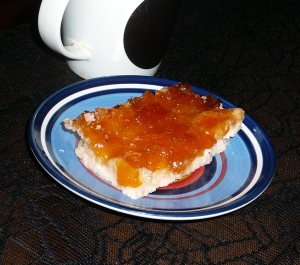Dinner parties at my house can be a little bit challenging, as I have a few friends with very restrictive dietary needs. In most cases, I simply end up preparing a variety of dishes, making sure that each guest has at least something available for them to eat. But on occasion I’ll try to make a dish that’s for everyone — and that’s where a creation like this one comes in.
It’s gluten-free, so my 2 friends with gluten intolerances can eat it. It has no coconut, no peanuts, no eggs, no soy, and no dairy. It’s vegan. And (this is important), it’s still delicious.
The Ingredients
- 1 cup vegetable shortening
- 1 cup sugar
- 1/2 tsp vanilla extract
- 1 shot of your favourite liquor or liqueur (I used brandy)
- 1-1/2 cups rice flour
- 1/2 cup tapioca starch
- 1 tsp salt
- 1/2 tsp baking powder (check to make sure it’s gluten-free; most are)
- 1/2 cup to 3/4 cup of your favourite type of jam (I used apricot) for topping
The Prep
Preheat your oven to 350 F, and line an 8 x 12 baking pan with parchment paper (this is important because sticky, baked-on jam is very, very annoying to clean up).
In a mixing bowl, cream together the sugar and shortening.
Add the rest of the wet ingredients (except for the jam) & mix well.
Add the dry ingredients (adding in 2 stages is recommended to prevent rice flour from “poofing” everywhere while you stir). No need to worry about overmixing, since this is gluten-free: just try to get a nice, even texture. The resulting dough will be very soft and crumbly.
** Note – if you want to make your shortbread into individual cookies or shapes, refrigerate it for 30 minutes to make the dough a little bit easier to work with. For cookie bars, though, this is unnecessary.
Press the dough into the bottom of your baking pan to create an even layer.
Spread jam over the top.
Bake for 30-40 minutes in the middle of the oven. The cookie bars are done when you start to get some delicious-looking caramelization at the edges of the jam layer.
When you first take the cookies out of the oven, they will be VERY soft. Use a butter knife to divide them into bars, then pop the whole thing into the fridge or freezer to cool down before attempting to remove them from the pan. Once the tapioca flour sets up, they’ll be a nice, slightly-crumbly shortbread texture, but until then they’ll be a bit of a fall-aparty mess.
Variations
To change it up a bit, try adding nuts or a streusel topping on top of the jam layer, or drizzle melted dark chocolate over the finished cookie bars.
To make easy, round cookies instead of bars, try using a muffin tin (or mini-muffin tins) — press a bit of dough into the bottom of each, then top with jam. Paper muffin-liners will help with preventing any sticking.
To make a thicker, layered bar, try using an 8 x 8 pan instead of an 8 x 12, and divide the dough in half. Press half into the bottom, top with jam, then add the other half of the dough, and top with more jam. Increase the cooking time by a few minutes to ensure even cooking.




